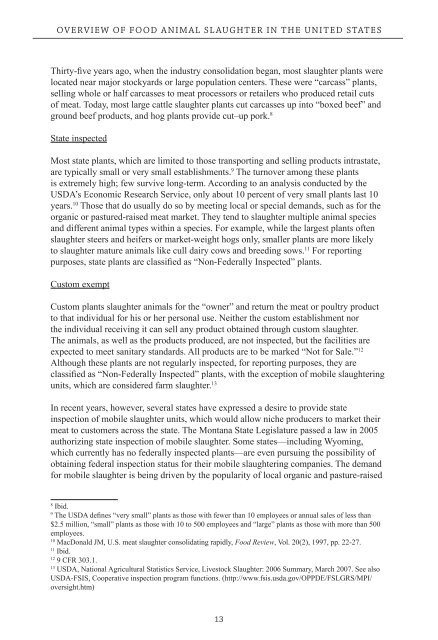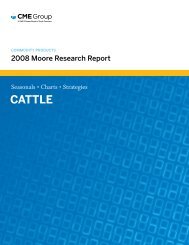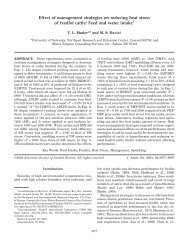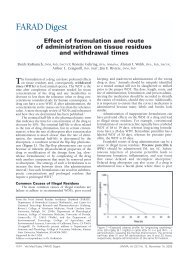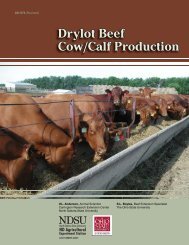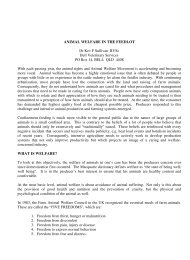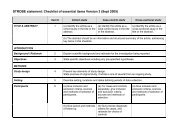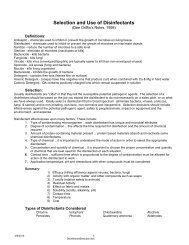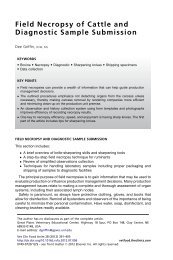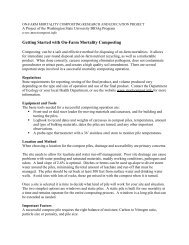CRIMES WITHOUT CONSEQUENCES - gpvec
CRIMES WITHOUT CONSEQUENCES - gpvec
CRIMES WITHOUT CONSEQUENCES - gpvec
Create successful ePaper yourself
Turn your PDF publications into a flip-book with our unique Google optimized e-Paper software.
overvieW of food animal slaughter in the united states<br />
Thirty-five years ago, when the industry consolidation began, most slaughter plants were<br />
located near major stockyards or large population centers. These were “carcass” plants,<br />
selling whole or half carcasses to meat processors or retailers who produced retail cuts<br />
of meat. Today, most large cattle slaughter plants cut carcasses up into “boxed beef” and<br />
ground beef products, and hog plants provide cut–up pork. 8<br />
State inspected<br />
Most state plants, which are limited to those transporting and selling products intrastate,<br />
are typically small or very small establishments. 9 The turnover among these plants<br />
is extremely high; few survive long-term. According to an analysis conducted by the<br />
USDA’s Economic Research Service, only about 10 percent of very small plants last 10<br />
years. 10 Those that do usually do so by meeting local or special demands, such as for the<br />
organic or pastured-raised meat market. They tend to slaughter multiple animal species<br />
and different animal types within a species. For example, while the largest plants often<br />
slaughter steers and heifers or market-weight hogs only, smaller plants are more likely<br />
to slaughter mature animals like cull dairy cows and breeding sows. 11 For reporting<br />
purposes, state plants are classified as “Non-Federally Inspected” plants.<br />
Custom exempt<br />
Custom plants slaughter animals for the “owner” and return the meat or poultry product<br />
to that individual for his or her personal use. Neither the custom establishment nor<br />
the individual receiving it can sell any product obtained through custom slaughter.<br />
The animals, as well as the products produced, are not inspected, but the facilities are<br />
expected to meet sanitary standards. All products are to be marked “Not for Sale.” 12<br />
Although these plants are not regularly inspected, for reporting purposes, they are<br />
classified as “Non-Federally Inspected” plants, with the exception of mobile slaughtering<br />
units, which are considered farm slaughter. 13<br />
In recent years, however, several states have expressed a desire to provide state<br />
inspection of mobile slaughter units, which would allow niche producers to market their<br />
meat to customers across the state. The Montana State Legislature passed a law in 2005<br />
authorizing state inspection of mobile slaughter. Some states—including Wyoming,<br />
which currently has no federally inspected plants—are even pursuing the possibility of<br />
obtaining federal inspection status for their mobile slaughtering companies. The demand<br />
for mobile slaughter is being driven by the popularity of local organic and pasture-raised<br />
8 Ibid.<br />
9 The USDA defines “very small” plants as those with fewer than 10 employees or annual sales of less than<br />
$2.5 million, “small” plants as those with 10 to 500 employees and “large” plants as those with more than 500<br />
employees.<br />
10 MacDonald JM, U.S. meat slaughter consolidating rapidly, Food Review, Vol. 20(2), 1997, pp. 22-27.<br />
11 Ibid.<br />
12 9 CFR 303.1.<br />
13 USDA, National Agricultural Statistics Service, Livestock Slaughter: 2006 Summary, March 2007. See also<br />
USDA-FSIS, Cooperative inspection program functions. (http://www.fsis.usda.gov/OPPDE/FSLGRS/MPI/<br />
oversight.htm)<br />
13


